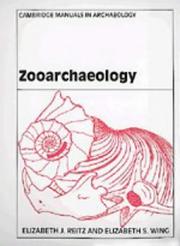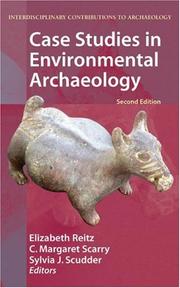| Listing 1 - 5 of 5 |
Sort by
|

ISBN: 9780521857260 0521857260 9780521673938 0521673933 1107486440 0511378793 0511377908 0511376995 9786611243333 0511841353 0511376057 0511374550 1281243337 0511372701 Year: 2008 Publisher: New York, N.Y. Cambridge University Press
Abstract | Keywords | Export | Availability | Bookmark
 Loading...
Loading...Choose an application
- Reference Manager
- EndNote
- RefWorks (Direct export to RefWorks)

ISBN: 0521485290 0521480698 Year: 1999 Publisher: Cambridge Cambridge University press
Abstract | Keywords | Export | Availability | Bookmark
 Loading...
Loading...Choose an application
- Reference Manager
- EndNote
- RefWorks (Direct export to RefWorks)
Animal remains (Archaeology) --- Restes d'animaux (Archéologie) --- Archaeozoology --- Zooarchaeology --- Zoology in archaeology --- Archaeology --- Bones --- Animal paleopathology --- Identification --- Methodology
Book
ISSN: 00659452 Year: 2010 Publisher: [New York] American Museum of Natural History
Abstract | Keywords | Export | Availability | Bookmark
 Loading...
Loading...Choose an application
- Reference Manager
- EndNote
- RefWorks (Direct export to RefWorks)
Animal remains (Archaeology) --- Guale Indians --- Nutritional anthropology --- Excavations (Archaeology) --- Food --- Economic conditions --- Mission Santa Catalina de Guale (Saint Catherines Island, Ga.) --- Spain --- Florida --- Colonies --- Economic conditions. --- History

ISBN: 9780387713021 Year: 2008 Publisher: New York Springer
Abstract | Keywords | Export | Availability | Bookmark
 Loading...
Loading...Choose an application
- Reference Manager
- EndNote
- RefWorks (Direct export to RefWorks)
Book

ISBN: 9780985201609 0985201606 Year: 2012 Publisher: [New York] American Museum of Natural History
Abstract | Keywords | Export | Availability | Bookmark
 Loading...
Loading...Choose an application
- Reference Manager
- EndNote
- RefWorks (Direct export to RefWorks)
Some of the most enduring and fundamental questions in archaeology relate to site seasonality. During which seasons did people occupy coastal archaeological sites? Why is "seasonality" important to our understanding of human behavior? What does this knowledge tell us about life in dynamic estuarine systems? What methods and technologies are available to address key issues of seasonality? Archaeological seasonality is uniquely linked to settlement patterns, resource availability, environmental relationships, anthropogenesis, landscapes, and social complexity. Archaeologists working in coastal settings typically recover multiple biological proxies that are well suited to explicating questions of human seasonal behavior. The Fifth Caldwell Conference was convened to discuss and report on practiced methods for reading the seasonality record found in common biological proxies. These researchers spoke of how they are applying various methods grounded in the natural sciences to estimate seasonality with particular reference to the archaeology of St. Catherines Island and the Georgia Bight. These methods include stable isotope analysis, ¹⁴C dating, longitudinal studies of animals (molluscs and fishes), zooarchaeology, and archaeobotany. The research shows that all plant and animal remains found in a midden contain a record of human behavior. The authors of these 13 chapters agree that multiple indicators of site seasonality provide the most robust picture of the annual settlement cycle. These papers were initially presented at the Fifth Caldwell Conference, cosponsored by the American Museum of Natural History and the St. Catherines Island Foundation, held on St. Catherines Island, Georgia, May 14-16, 2010.
Land settlement patterns, Prehistoric --- Food supply --- Coastal settlements --- Migration, Internal --- Indians of North America --- Fish remains (Archaeology) --- Animal remains (Archaeology) --- Plant remains (Archaeology) --- Coastal archaeology --- Seasonal variations --- Food --- Atlantic Coast (South Atlantic States) --- Saint Catherines Island (Ga.)
| Listing 1 - 5 of 5 |
Sort by
|

 Search
Search Feedback
Feedback About UniCat
About UniCat  Help
Help News
News